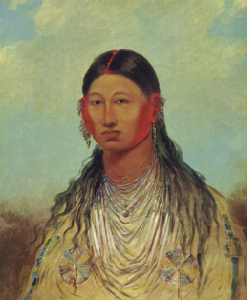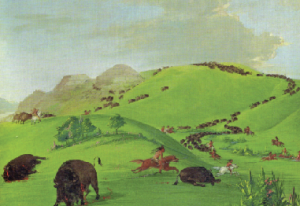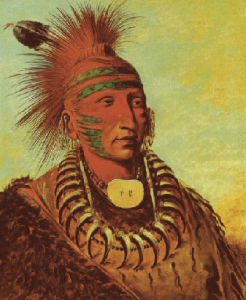Dances with Dublin: George Catlin’s ‘Indian Gallery’
Published in 18th–19th - Century History, Featured-Archive-Post, Features, Issue 6 (November/December 2013), Volume 21
Koon-za-va-me (Female War Eagle), one of George Catlin’s Iowa troupe, who visited Ireland in 1845. (Smithsonian American Art Gallery)
An exhibition—‘George Catlin: American Indian Portraits’—opened earlier this year in the National Portrait Gallery, London, with the bull buffaloes of British art criticism, Brian Sewell and Andrew Graham-Dixon, locking horns over whether the self-taught Pennsylvanian was any use as a painter. The show has since moved to the Birmingham Museum and Art Gallery. It is a pity that it will not be shown in Ireland as well, because when Catlin originally displayed his ‘Indian Gallery’ in Europe in the 1840s he came to Ireland twice.
A romantic and an opportunist
Catlin was a romantic and also an opportunist. By the late 1820s, having given up a law career, he was already an established painter of portraits and crowd scenes; indeed, he had already executed the frequently used one of New York’s Five Points district, which was to become so famous in Irish-American history. After Andrew Jackson signed the Indian Removal Act of 1830, to achieve the ‘ethnic cleansing’ of the tribes east of the Mississippi, Catlin had the idea of painting the original Americans and recording their customs before they died out in the face of the inexorable advance of white civilisation. The result was several journeys into the West by paddle-steamer and canoe, during which he enjoyed the hospitality of several different tribes. He painted their still-pristine environment and their many strange rituals, but his portraits were by far the most impressive. Precisely because of his lack of training, his portraits of them were not classicising. The men are conveyed with a starkness and solemnity, and the women—significantly he portrayed them too—are as stoic as Whistler’s mother. They are assuredly part of a distinct and proud race, yet each comes across as an individual. Back East, he set up his Indian Gallery—300-odd portraits, nearly 200 landscapes and crowd scenes and a huge collection of artefacts, including clothes, weapons and a host of other tribal paraphernalia, complete with a 7m-high tepee—and gave illustrated lectures on Indian culture. Apart from portraits of Indian chiefs famous for their resistance to the government, such as Black Hawk of the Sac and Osceola of the Seminoles, the public response to his show was unenthusiastic, so he decided to ship his stuff—six tons of it—to Europe.
The Indian Gallery was now set up in London’s Piccadilly. The English audiences were more sympathetic to the plight of the Indians, and Catlin himself could be more disdainful of US government policies. For a time his book Letters and notes on the manners, customs, and condition of the North American Indians (1841), which enjoyed extremely positive reviews, boosted attendances. It carried many of his illustrations and reversed the polarities of debate, being the first book since Las Casas’ A short history of the destruction of the Indies (1552) to portray the Indians as victims of wanton violence rather than its perpetrators. Empathy did not make the show any money, though. First grizzly bears and then live Indians were introduced. Catlin employed a group of nine Ojibwas from Ontario and later fourteen Iowas from Upper Missouri to perform Indian dances—war dances, buffalo hunts, pipe of peace ceremonies—and to demonstrate feats of archery and ball games. These displays were popular. Dickens was unimpressed by the Ojibwas dancing ‘miserable jigs after their own dreary manner’, but Queen Victoria invited them to Windsor Castle for a command performance. They then went on tour. Everywhere they went the main attraction was a lurid one—scalping.
The Indian Gallery in Ireland

Buffalo chase at mouth of the Yellowstone River, 1832–33. This and similar paintings by Catlin influenced the imaging of Kevin Costner’s 1990 Dances with Wolves. (Smithsonian American Art Gallery)
In the early summer of 1843 they crossed from Scotland to Ireland. The show was performed first at the Music Hall in May Street, Belfast, and then at the Concert Room of the Rotunda in Dublin, where it was advertised as ‘The Last of the Red Indians’.
When Catlin announced plans to bring the Ojibwas back to Ireland in 1844 and then cancelled it, one wag reckoned that his Indian braves weren’t brave enough to face the Ribbonmen of Ireland! He did, however, return with the Iowas in February and March 1845. He preferred the Iowas to Ojibwas; having less contact with white society, they were more cleanly, more sober, more defiant, more like the noble savages he respected and the audience expected. They were also Americans rather than Canadians and he had already painted three of them—the hereditary chief, Mew-hu-she-kaw (White Cloud), the war chief, Neu-mon-ya (Walking Rain), and one of the warriors, Wash-ka-mon-ya (Fast Dancer), in their own village. It was they who were allotted most space in his follow-up book, Catlin’s notes of eight years’ travel and residence in Europe with his North American Indian Gallery (1848). The Irish chapter is a hoot, full of incidents and interactions. The show only came to Dublin and was put on first at the Rotunda but then moved to the larger venue of the Music Hall (now the Olympia), which had more room for all the props and displays.
Catlin had the Indians careering about the city in open coaches to boost attendances. They had an eager tour guide in Catlin’s long-time assistant and Irish road manager, Daniel Kavanaugh. This avid quoter of statistics from The Times gave a running commentary of pro-Chartist, pro-Repeal sentiments. When the Indians saw the deer in Phoenix Park and wanted to go back into town to collect their bows and arrows, Daniel launched into an attack on the anti-poaching laws; when they wondered why Ireland had so many more policemen than London, he told them that Ireland was a subjugated country whose workforce was being exploited. To celebrate their arrival in his native country, he put on a slap-up dinner for the Indians, topped off by their favourite drink, the queen’s chickaboboo (champagne).
Encounters with dignitaries

No-ho-mun-ya (One Who Gives No Attention, a.k.a. Roman Nose). This Iowa, painted by Catlin in London in 1844, became ill in Ireland and died in Liverpool the following year. (Smithsonian American Art Gallery)
Walking Rain left Richard Whately, the Church of Ireland archbishop of Dublin, who had given each Indian a sovereign, dumbfounded. On taking leave of this prelate, Walking Rain told him that the Great Spirit was sure to arrange for them to meet again in the next world!
The archbishop was one of a number of dignitaries they encountered. At Trinity College Dr Todd showed the Indians the university’s library and museum, and Dr Singer sat them down and gave them a lecture on Christianity. The Iowas were particularly anxious to meet the Quakers, whom they had heard were numerous in Dublin, and they had sent them letters of introduction in advance. The Friends, pro-Indian since the days of William Penn, did not disappoint. A special performance was put on for the Quakers, and at the end the Iowas received a donation of £40 and several presents. Hearing directly about their plight, the Quakers advocated that they give up fighting and hunting and live as peaceful farmers, and were pleased to hear that they already had a mission school. Then they were invited outside the city to Joseph Bewley’s house, where they had breakfast and another enlightening sermon. They also visited Quaker philanthropist Joshua Abell, who wrote about their visit in his Dublin Literary Journal. A famous anti-slaver and peace activist, he was willing to take on board Catlin’s justification of scalpings—that they were the incidental results rather than actual causes of Indian aggression. Abell was also interested in electricity and its medical benefits, and they allowed him to seat them on an insulated stool and pass currents through their bodies. Although they were amused by this, White Cloud also wanted his son, who had a fever, connected up. This was almost certainly No-ho-mun-ya (One Who Gives No Attention), also known as Roman Nose, who was sick on this leg of their tour and who died on reaching Liverpool.
Visit to the zoo

George Catlin by William Fisk, 1849. (National Portrait Gallery, Smithsonian Institute)
It was the Quakers who arranged for the Indians to visit the Zoological Gardens, ‘then in their infant but very flourishing state’. They set up their camp there, as they had earlier done in Vauxhall Gardens in London; the Indians got the £36 gate money and the Zoo got to show off its pair of American bison. They also visited the Royal Dublin Society, probably under a similar arrangement and possibly also at the suggestion of the Quakers. By the time all these meetings were over, the Indians were overburdened with Bibles. A particularly enterprising one wanted to swap them for subscriptions to Punch and The Times, but the Bibles were retained and they settled for The Times, as they were mightily taken by its many tabloid headlines about murders, robberies and hangings. Above all, the Iowas were astounded by the levels of public drunkenness and poverty throughout the United Kingdom. They found this to be the case especially in Glasgow and Dublin. As in Glasgow, the Indians threw money to the Irish beggars as they passed along in their coaches. In the end this meant that the beggars followed them back to their hotel and waited under the windows for more to be disbursed. The Indians gave away a lot of the money they had been given in Dublin in this fashion. They left declaring that Dublin was not as beautiful a city as Edinburgh but that it was by far the most welcoming place they had visited.
Afterwards Catlin moved his show to Paris—where he had a six-month run at the Louvre and at last received the attention of intellectuals that he had long craved—but his Indian Gallery never made a profit and by 1852 he was back in London in debtor’s prison. Catlin was a pioneer of anthropology who proposed a museum of mankind; his Indian paintings and, indeed, his account of the Indians’ visit to Dublin are in different ways valuable records and both well worth a look. HI
Hiram Morgan lectures in history at University College Cork.
Read More: Reviewed in The Nation
Heckled
Further reading
G. Catlin, Letters and notes on the manners, customs, and condition of the North American Indians (London, 1841).
G. Catlin, Catlin’s notes of eight years’ travel and residence in Europe with his North American Indian Gallery (London, 1848).
















